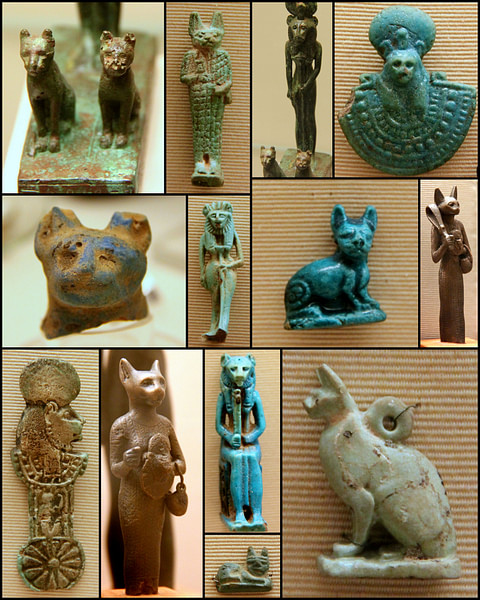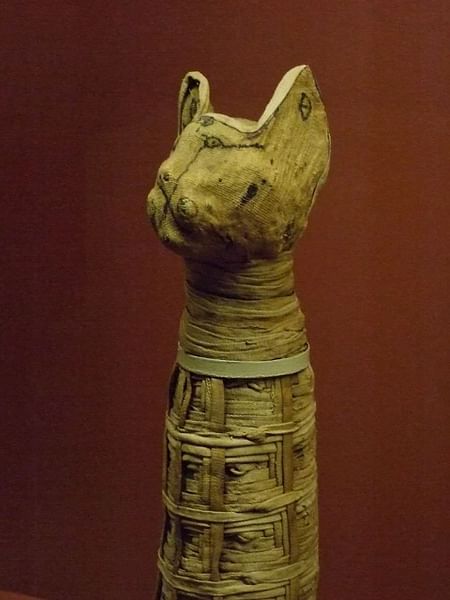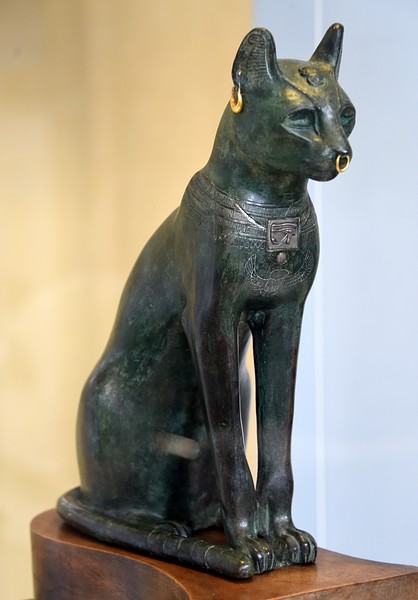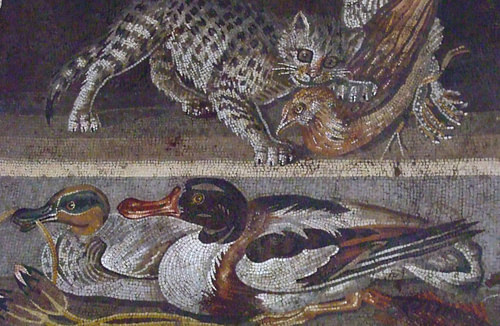Egyptian Myth a Treasury of Legends Art and History Mla Citation
Cats and humans accept shared in each other'southward lives for thousands of years and, fifty-fifty though they have not ever been regarded as highly as in the nowadays, have played an important office in a number of cultures. Always enigmatic, the cat has sometimes been mistrusted by various civilizations simply always managed to prove their worth.
Although it has been commonly accepted that cats were starting time domesticated in Egypt 4000 years ago, their history among human beings goes dorsum much further. Wild cats are at present known to take lived amidst the people of Mesopotamia over 100,000 years agone and to have been domesticated there approximately 12,000 BCE at about the aforementioned time as dogs, sheep, and goats. Archaeological excavations in the past ten years accept provided bear witness that the Near Eastern Wildcat is the closest relative of the modern-day domestic cat and was bred by Mesopotamian farmers, most probably as a ways of controlling pests, such as mice, which were attracted by grain supplies.
The writer David Derbyshire cites a 2007 CE research project in which, "the study used Deoxyribonucleic acid samples from 979 wild and domestic cats to piece together the feline family tree. They looked for markers in mitochondrial DNA - a type of genetic material passed down from mothers to kittens which can reveal when wild and domestic cat lineages were most closely related." This project was headed by Dr. Andrew Kitchener, a Zoologist at the National Museums of Scotland, who writes, "This shows that the origin of domestic cats was non Aboriginal Egypt - which is the prevailing view - but Mesopotamia and that it occurred much earlier than was thought. The last common ancestor of wildcats and domesticated cats lived more than than 100,000 years ago" (Derbyshire).
Dr. Kitchener'south findings built upon the evidence of cat'due south domestication provided past the discovery in 1983 CE of a cat skeleton in a grave dating to 9,500 BCE on the island of Republic of cyprus. This detect, fabricated past the archaeologist Alain le Brun, was important because Cyprus had no ethnic cat population and information technology is unlikely that settlers would have brought a wild cat, by boat, to the isle.

Bastets & Sekhmets
Cats in Aboriginal Egypt
The cat's clan with aboriginal Egypt, nonetheless, is understandable in that Egyptian culture was famous for its devotion to the true cat. The export of cats from Egypt was so strictly prohibited that a co-operative of the government was formed solely to bargain with this result. Government agents were dispatched to other lands to discover and render cats which had been smuggled out. It is clearly established that, by 450 BCE, the punishment in Arab republic of egypt for killing a cat was death (though this law is idea to have been observed much before). The goddess Bastet, commonly depicted equally a cat or as a woman with a true cat'due south head, was among the most pop deities of the Egyptian pantheon. She was the keeper of hearth and dwelling house, protector of women'southward secrets, guardian against evil spirits and disease, and the goddess of cats.
Her ritual centre was the city of Bubastis ("House of Bastet") in which, according to Herodotus (484-425 BCE), an enormous temple complex was built in her honour in the centre of the city. Herodotus likewise relates that the Egyptians cared and so much for their cats that they placed their condom to a higher place human life and property. When a house caught fire, the Egyptians would concern themselves more with rescuing the cats than with anything else, oft running back into the burning building or forming a perimeter effectually the flames to continue cats at a safe distance.
When a cat died, Herodotus writes, "All the inhabitants of a house shave their eyebrows [equally a sign of deep mourning]. Cats which take died are taken to Bubastis where they are embalmed and buried in sacred receptacles" (Nardo 117). The period of mourning was considered completed when the people's eyebrows had grown back. Mummified cats accept been found at Bubastis and elsewhere throughout Egypt, sometimes buried with, or near to, their owners every bit evidenced by identifying seals on the mummies.
The greatest example of Egyptian devotion to the cat, however, comes from the Battle of Pelusium (525 BCE) in which Cambyses Ii of Persia defeated the forces of the Egyptian Pharaoh Psametik III to conquer Egypt. Knowing of the Egyptian's love for cats, Cambyses had his men round up diverse animals, cats importantly amidst them, and drive the animals earlier the invading forces toward the fortified city of Pelusium on the Nile.
The Persian soldiers painted images of cats on their shields, and may have held cats in their arms, as they marched behind the wall of animals. The Egyptians, reluctant to defend themselves for fear of harming the cats (and perhaps incurring the death penalty should they kill ane), and demoralized at seeing the image of Bastet on the enemy's shields, surrendered the urban center and allow Egypt fall to the Persians. The historian Polyaenus (second century CE) writes that, afterwards the surrender, Cambyses rode in triumph through the urban center and hurled cats into the faces of the defeated Egyptians in scorn.

True cat Mummy
The Egyptians are besides responsible for the very proper noun `cat' in that it derives from the North African word for the animal, "quattah", and, as the true cat was so closely associated with Egypt, virtually every other European nation employs variations on this word: French, chat; Swedish, katt; High german, katze; Italian, gatto; Spanish, gato and and then forth (Morris, 175). The colloquial give-and-take for a cat - `puss' or `pussy' - is besides associated with Egypt in that it derives from the word Pasht, another name for Bastet.
Cats In India
Cats are mentioned in the two bang-up literary epics of ancient India, The Mahabharata and The Ramayana (both c. 5th/4th century BCE). In Mahabharata a famous passage concerns the cat Lomasa and the mouse Palita, who assist each other escape from expiry and discuss at length the nature of relationships, particularly those in which one of the parties is stronger or more powerful than the other. In the Ramayana, the god Indra disguises himself as a cat after seducing the beautiful maid Ahalya equally a means to escape from her married man. As was the instance everywhere else, cats in Republic of india were plant to exist particularly useful in controlling the populations of less desirable creatures like mice, rats, and snakes and and then were honoured in the homes, farms, and palaces throughout the state.
That the cat was seen as more than only a method of pest control is substantiated by the reverence accorded to felines in the literature of Bharat. The famous story of Puss in Boots (best known through the French version past Charles Perrault, 1628-1703 CE) is taken from a much older Indian folk tale in the Panchatantra from the fifth century BCE (though the character of the true cat's primary has a very different personality in the older tale than the one in Perrault's story). The esteem in which cats were held is also evident in the Indian cat goddess, Sastht, who served much the same role as Bastet and was as greatly revered.
The Western farsi True cat
A Farsi tale claims the cat was created magically. The groovy Persian hero Rustum, out on campaign, i dark saved a magician from a ring of thieves. Rustum offered the older homo the hospitality of his tent and, as they sat exterior nether the stars, enjoying the warmth of a fire, the wizard asked Rustum what he wished for as a gift in repayment for saving the man'southward life. Rustum told him that there was nothing he desired since everything he could want, he already had before him in the warmth and comfort of the fire, the aroma of the smoke and the beauty of the stars overhead. The magician and so took a handful of smoke, added flame, and brought down ii of the brightest stars, kneading them together in his hands and blowing on them. When he opened his hands toward Rustum, the warrior saw a small, smoke-grey kitten with eyes bright as the stars and a tiny tongue which darted like the tip of flame. In this fashion, the first Persian cat came to be created as a token of gratitude to Rustum.
The prophet Muhammed was besides very fond of cats. According to legend, the `M' pattern on the forehead of the tabby cat was fabricated when the prophet blessed his favourite cat by placing his paw on its head. This cat, Meuzza, also features in another famous story in which Muhammed, chosen to prayer, found the cat asleep on his arm. Rather than disturb the cat, Muhammed cut the sleeve from his robe and left Meuzza to sleep. The status of the cat, therefore, was further enhanced past its association with a figure of divinity.

The Gayer-Anderson Cat
Cats in China and Nippon
This was also truthful in China where the goddess Li Shou was depicted in true cat course and petitions and sacrifices made to her for pest control and fertility. She too, was a very popular goddess who was idea to embody the importance of cats in the early days of creation. An ancient Chinese myth relates that, in the beginning of the world, the gods appointed cats to oversee the running of their new cosmos and, in order for communication to be clear, granted cats the ability of speech. Cats, however, were more interested in sleeping beneath the crimson trees and playing with the falling blossoms than with the mundane task of having to pay attention to the operation of the earth.
Iii times the gods came to check on how well the cats were doing their task and all three times were disappointed to discover their feline overseers asleep or at play. On the god'due south tertiary visit, the cats explained they had no interest in running the world and nominated human beings for the position. The ability of voice communication was then taken from the cats and given to humans but, as humans seemed incapable of understanding the words of the gods, cats remained entrusted with the important job of keeping time and so maintaining society. It was idea that one could tell the time of day past looking into a cat's optics and this belief is still maintained in Communist china.
In Nippon, the famous image of the `Beckoning Cat' (the maneki neko figure of the cat with one raised mitt) represents the goddess of mercy. The fable goes that a cat, sitting outside of the temple of Gotoku-ji, raised her paw in acknowledgement of the emperor who was passing by. Attracted by the cat's gesture, the emperor entered the temple and, moments later, lightning struck the very spot where he had been standing. The true cat, therefore, saved his life and was accorded great honours.
The Beckoning True cat paradigm is thought to bring proficient luck when given as a gift and remains a very popular present in Japan. The cat was regularly considered a guardian of the home and was thought to exist the special protector of valuable books. Cats were often housed in individual pagodas in Nippon and were considered so valuable that, by the 10th century CE, only the dignity could afford to own one.

Mosaic, Pompeii
Cats in Hellenic republic and Rome
Although cats were kept by people in Greece and Rome, the appreciation for the animal as a hunter was not as great in those cultures attributable to the Greek and Roman practice of keeping domesticated weasels for pest control. The Romans regarded the cat equally a symbol of independence and not every bit a creature of utility. Cats were kept as pets by both Greeks and Romans and were regarded highly.
A first century CE epitaph of a young daughter belongings a cat is among the earliest pieces of evidence of cats in Rome and, in Hellenic republic, the playwright Aristophanes (c. 446-386 BCE) oft featured cats in his works for comic effect (coining the phrase, "The true cat did it" in assigning blame). Amid ancient civilizations, however, the cat was probably least pop among the Greeks owing to its clan in certain myths with the goddess of death, darkness and witches, Hecate, who is more commonly associated with the dog (equally is her Roman conterpart, Trivia). A much later development in Greek appreciation for the cat is evidenced in the legend that the cat protected the baby Jesus from rodents and snakes and then is accorded the best of spots in a Greek domicile but, originally, they exercise non seem to accept been regarded highly.
Cats are thought to have been brought to Europe by Phoenician traders who smuggled them out of Egypt. As the Phoenicians are acknowledged to accept extensively traded with every known culture of the time, cats could have been spread effectually the region on a fairly regular basis. It is well documented that cats were kept on ships to control vermin during the time of the 15th century CE Age of Discovery and, about likely, they served the same purpose for the Phoenicians. If the Phoenicians did bring the true cat to Europe, equally seems very probable, they may have as well introduced the Greek association of the cat with Hecate. As noted above, Hecate was associated with dogs regularly merely one story in particular, which was quite popular, links the dark goddess with the true cat.
The Greek myth which suggests this link is the well known story of Heracles (the Roman Hercules) and concerns Galinthius, a maid-retainer to Heracles' female parent, the Princess Alcmene. The god Zeus seduced Alcmene and she became pregnant with Heracles. Zeus' wife, Hera, was thwarted in her try to kill Alcmene and Heracles through the cleverness of Galinthius. Enraged, Hera transformed Galinthius into a cat and sent her to the underworld to ever afterward serve Hecate. This story was popularized by the Latin writer Antoninus Leberalis (2nd century CE) in his Metamorphosis, a retelling of older tales, which was pop enough to be copied and distributed up through the ninth century CE and to enjoy a wide readership through at to the lowest degree the 16th century CE. This myth, then, associated cats with darkness, transformation, the underworld, and witchcraft and, in fourth dimension, these associations would prove very unfortunate for the cat.
Cats equally Demonic Figures
Although cats seem to accept enjoyed their ancient high standing in European countries at first (in Norse mythology, for case, the great goddess Freya is depicted in a chariot drawn by cats and in both Ireland and Scotland cats are depicted as magical in a positive sense) the Christian Church building, post-obit their regular course of demonizing of import pagan symbols, drew on the pre-existing link betwixt the cat and witchcraft to associate cats with evil as personified in the Devil. The medieval author Walter Map (c. 1140-1210 CE) associated the cat with demonic forces in his work (although information technology is possible Map was being stirical) and in that location are records of cats beingness ritually killed in Cambridge England in the early 13th century CE.
The reputation of the true cat took a more than serious downwardly plough, however, after Pope Gregory 9 (1227-1241 CE) issued his papal bull known as Vox in Rama in 1233 CE denouncing cats as evil and in league with Satan, cats - and particularly black cats - were demonized to the betoken where they were regularly killed all across Europe. It should not exist assumed that the common people would have read Vox in Rama and responded to it, nor even that the bull was widespread (it was issued but to Henry Iii, Count of Sayn, in Germany) but the opinion of the church toward cats would certainly have filtered down from the highest levels to the lay-people of the congregations.
It has long been argued that the death of then many cats allowed the mice and rat populations to thrive and that the fleas these vermin carried brought most the Bubonic Plague of 1348 CE. While this theory has been disputed, there seems no doubt that a decrease in the true cat population would result in an increase in the number of mice and rats and it is established that there was such a decrease in the number of cats prior to 1348 CE. Fifty-fifty though recent studies have ended that the plague was spread through human interaction (non through interaction with rodents) information technology was still the parasites from rats and mice which carried the plague. People of the fourth dimension, however, had no thought where the plague came from (the bacterium Yersinia pestis,which causes plague, was non isolated until 1894 CE) and saw no correlation between the number of rodents, cats, and the disease; therefore cats continued to exist doubtable of all manner of sick-will and unsafe attributes.
Desmond Morris writes, "Because the cat was seen as evil, all kinds of frightening powers were attributed to it by the writers of the day. Its teeth were said to be venomous, its mankind poisonous, its pilus lethal (causing suffocation if a few were accidentally swallowed), and its breath infectious, destroying human lungs and causing consumption" and further states, "As belatedly as 1658 Edward Topsel, in his serious piece of work on natural history, [wrote] `the familiars of Witches do most commonly announced in the shape of Cats, which is an argument that this beast is unsafe to soul and body" (158). The inhabitants of the European nations, believing the cat to be evil, shunned non simply the animal but anyone who seemed overly fond of the cat. Elderly women who cared for cats were especially susceptible to penalisation for witchcraft just on the grounds of existence so defendant.
The Victorian Age and Cat Vindication
Cats survived these frenzied superstitions better than many of their human companions and during the Enlightenment of the 18th century were elevated to the status of pampered pets. This was due to the spirit of the age and the new paradigm of reason prevailing over superstition. The ability of the church in dictating pop opinion had been broken by the Protestant Reformation (1517-1648 CE) and in the Historic period of Enlightenment people could choose to believe what they wanted to regarding cats or any other subject.
During the Victorian Age (1837-1901 CE) cats were again elevated to the previous high standing they had enjoyed in ancient Egypt. Queen Victoria of Bang-up Britain, who had e'er kept dogs as pets, became interested in cats through the many stories of archaeological finds in Egypt being published regularly in England. Many of these stories included descriptions of the Egyptian reverence for cats, images of statues of Bastet, and the feline association with the gods and monarchy. The queen'southward interest in the cat led her to adopt ii Blue Persians whom she treated as members of her courtroom. This story was carried by the newspapers of the day and, as Queen Victoria was a very popular monarch, more and more people became interested in having cats of their own.
This tendency spread to the United States and was encouraged by the most pop magazine in America at that fourth dimension, Godey's Lady's Book. Published by Louis A. Godey of Philadelphia from 1830 -1878, this monthly periodical featured stories, articles, poems, and engravings and is perhaps all-time known for helping to institutionalize the practice of the family Christmas tree in America (although it as well advocated for women's rights, education, the commemoration of Thansgiving, and was among the first to publish Edgar Allen Poe's work).
In 1836 CE, the brilliant editor and writer Sarah Josepha Hale joined Godey's and greatly enhanced its reputation and circulation. In an 1860 article, Unhurt wrote that cats were not solely for older women or monarchs and that anyone should feel comfy in embracing the "dearest and virtue" of the cat. Cat popularity in the United States grew appreciably after the Godey article. Cats first came to North America, it is thought, in 1749 CE, from England, to help control the mice and rat population but they seem to have been largely considered commonsensical until the Victorian Age when they became cherished pets and, in the United states of america, this was largely due to the influence of Godey's Lady's Book and Sarah Hale'southward contributions to information technology.
Popularity of Cats
Many writers of the age endemic and admired cats. Charles Dickens was so devoted to his cats that he allowed them into his study and regularly immune his favorite (known as The Primary's Cat) to snuff out the candle on Dickens' writing desk even when the author was at work. Patently, the cat would grow tired of Dickens' attending being directed toward the page instead of to feline companionship and petting (Morris, 167). Mark Twain, William Wordsworth, John Keats, and Thomas Hardy were all neat admirers of the true cat and Lewis Carroll, of course, created i of the most enduring images of the feline through the Cheshire True cat in his Alice'southward Adventures in Wonderland.
The first major Cat Prove was held at the Crystal Palace in London in 1871CE and appreciation of the cat was elevated to such a level that, for the first time, cats were given "specific standards and classes" which are notwithstanding used to categorize felines in the present day (Morris, 148). Cat shows became increasingly popular afterwards this event and interest in breeding and showing cats spread throughout Europe and North America. The commencement true cat show in America (in 1895 CE) was and so popular that it was held at the large venue of Madison Foursquare Garden in Manhattan. From agents of pest control to divine or semi-divine creatures, to incarnations of evil, and, finally, to business firm pets, cats have been the close associates of human beings for centuries. They continue to be valued companions for people beyond the globe today and, in this, these individuals carry on the legacy of the ancients in their devotion to, and appreciation for, the cat.
This article has been reviewed for accuracy, reliability and adherence to academic standards prior to publication.
Source: https://www.worldhistory.org/article/466/cats-in-the-ancient-world/
0 Response to "Egyptian Myth a Treasury of Legends Art and History Mla Citation"
Post a Comment